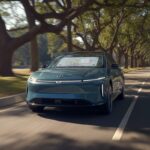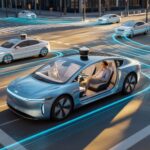
Smart Charging Technologies: A Comprehensive Report
The rapid growth of electric vehicles (EVs) has placed increasing demands on the electrical grid.
To address this challenge, smart charging technologies have emerged as a critical solution.
By intelligently managing the charging process, smart charging optimizes grid utilization, reduces peak demand, and enhances the overall EV ownership experience.
This report delves into the intricacies of smart charging technologies, exploring their benefits, challenges, and future prospects.
Understanding Smart Charging
Smart charging involves the intelligent management of EV charging processes to optimize grid utilization, reduce peak demand, and potentially lower electricity costs for EV owners. It typically involves:
- Vehicle-to-Grid (V2G) technology: Enables EVs to feed electricity back into the grid during peak demand periods, functioning as distributed energy storage resources.
- Load management: Distributes charging loads across different time periods to avoid overloading the grid.
- Price-responsive charging: Allows EVs to charge at times when electricity prices are lower.
- Demand response: Enables grid operators to remotely control EV charging to balance grid supply and demand.
Benefits of Smart Charging
- Grid optimization: Reduces strain on the electrical grid by shifting charging loads to off-peak hours.
- Cost savings: Enables EV owners to benefit from lower electricity rates by charging during off-peak periods.
- Increased grid reliability: Helps prevent blackouts and brownouts by balancing grid supply and demand.
- Enhanced EV ownership experience: Provides EV owners with greater control over their charging schedules and costs.
- Environmental benefits: Can facilitate the integration of renewable energy sources into the grid.
Smart Charging Technologies
-
Vehicle-to-Grid (V2G) Technology:
- Enables bidirectional power flow between the EV and the grid.
- Offers grid services such as frequency regulation and voltage support.
- Requires advanced battery management systems and power electronics.
-
Load Management:
- Distributes charging loads across different time periods to avoid overloading the grid.
- Can be implemented through smart charging stations or vehicle-based algorithms.
- Requires accurate load forecasting and real-time grid data.
-
Price-Responsive Charging:
- Adjusts charging schedules based on real-time electricity prices.
- Requires communication between the charging station and the electricity provider.
- Can be combined with other smart charging strategies for maximum benefits.
-
Demand Response:
- Enables grid operators to remotely control EV charging to balance grid supply and demand.
- Requires secure communication and control systems.
- Offers potential revenue streams for EV owners through participation in demand response programs.
Challenges and Considerations
- Battery degradation: Frequent deep discharges associated with V2G can potentially accelerate battery aging.
- Grid infrastructure: The grid must be sufficiently robust to handle bidirectional power flow.
- Consumer acceptance: Educating consumers about the benefits of smart charging and addressing concerns about potential impacts on EV usability is crucial.
- Data privacy and security: Protecting sensitive data related to EV charging and grid operations is essential.
- Interoperability: Ensuring compatibility between different EV models, charging stations, and grid systems is vital.
Future Outlook
Smart charging is poised to play a pivotal role in the transition to a clean energy future.
As EV adoption continues to grow, advancements in battery technology, charging infrastructure, and grid management will further enhance the capabilities of smart charging systems.
Integration with renewable energy sources, such as solar and wind power, will create new opportunities for optimizing grid utilization and reducing carbon emissions.
Smart charging technologies offer significant benefits for both EV owners and grid operators.
By intelligently managing the charging process, these technologies can help to optimize grid utilization, reduce costs, and enhance the overall EV ownership experience.
While challenges remain, ongoing research and development efforts are addressing these issues, paving the way for a sustainable and efficient electric transportation future.
The Impact of Electric Vehicles on the Grid
The increasing adoption of electric vehicles (EVs) presents both challenges and opportunities for the electric grid.
The potential impact can be significant, as the charging of millions of EVs could place substantial strain on the grid, particularly during peak demand periods.
However, with careful planning and the implementation of smart charging technologies, EVs can also contribute to grid stability and resilience.
Challenges
-
Increased Load on the Grid:
- Peak Demand: The simultaneous charging of a large number of EVs can lead to increased peak demand, potentially overloading the grid and causing blackouts or brownouts.
- Infrastructure Strain: The existing grid infrastructure may not be adequately equipped to handle the increased electricity demand from EVs.
- Peak Demand: The simultaneous charging of a large number of EVs can lead to increased peak demand, potentially overloading the grid and causing blackouts or brownouts.
-
Grid Stability Issues:
- Voltage Fluctuations: The rapid charging and discharging of EVs can cause fluctuations in voltage levels, impacting the stability of the grid.
- Frequency Instability: Large-scale EV charging can contribute to frequency deviations, which can disrupt grid operations.
Opportunities
-
Demand Response:
- EVs can participate in demand response programs, where grid operators can remotely control charging to balance supply and demand.
This helps to reduce peak demand and improve grid stability.
- EVs can participate in demand response programs, where grid operators can remotely control charging to balance supply and demand.
-
Grid Services:
- Vehicle-to-Grid (V2G) technology enables EVs to feed electricity back into the grid during peak demand periods, providing grid support services.
This can help to stabilize the grid and reduce the need for additional power plants.
Peak Shaving:
- By shifting EV charging to off-peak hours, smart charging technologies can help to reduce peak demand and flatten the load curve.
This can lead to cost savings for both EV owners and utilities.
- By shifting EV charging to off-peak hours, smart charging technologies can help to reduce peak demand and flatten the load curve.
- Vehicle-to-Grid (V2G) technology enables EVs to feed electricity back into the grid during peak demand periods, providing grid support services.
-
Renewable Energy Integration:
- EVs can help to integrate renewable energy sources, such as solar and wind, into the grid by storing excess energy during off-peak hours and discharging it when needed.
- EVs can help to integrate renewable energy sources, such as solar and wind, into the grid by storing excess energy during off-peak hours and discharging it when needed.
Mitigating Challenges and Maximizing Opportunities
To address the challenges and capitalize on the opportunities presented by EV adoption, a combination of strategies is necessary:
- Smart Grid Technologies: Implementing advanced metering infrastructure, communication networks, and control systems to enable real-time monitoring and management of grid conditions.
- Grid Infrastructure Upgrades: Investing in grid reinforcement and expansion to accommodate the increased electricity demand from EVs.
- Incentives and Policies: Promoting the adoption of smart charging technologies and providing incentives for EV owners to participate in demand response programs.
- Time-of-Use Pricing: Implementing time-of-use electricity rates to encourage EV charging during off-peak hours.
- V2G Technology Development: Accelerating the development and deployment of V2G technology to enable EVs to provide grid services.
By carefully managing the integration of EVs into the grid, it is possible to mitigate the challenges and unlock the full potential of this emerging technology.


